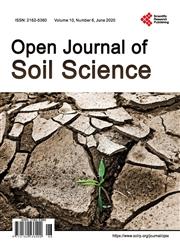Microbial Properties of a Ferric Lixisol as Affected by Long Term Crop Management and Fertilization Regimes in Burkina Faso, West Africa
引用次数: 1
Abstract
We used an ongoing long-term field trial established since 1960 in Burkina Faso, to study the microbial properties of a Ferric Lixisol under various crop management and fertilization regimes. Microbial respiration rate, microbial biomass carbon (MBC) and soil bacteria’s number were assessed in soil samples taken at 0 - 20 cm depth. The crop management were continuous cropping of sorghum (Sorghum bicolor L.) (S/S) and rotation between sorghum and cowpea (Vigna unguiculata L.) (S/C), while the fertilization regimes were: 1) Control (te); 2) Low rate of mineral fertilizer (fm); 3) Low rate of mineral fertilizer + sorghum straw restitution (fmr); 4) Low rate of mineral fertilizer + low rate of manure (fmo); 5) High rate of mineral fertilizer (FM); and vii) High rate of mineral fertilizer + high rate of manure (FMO). The manure is applied every second year. The results indicate that sorghum/cowpea rotation significantly increase MBC and bacteria number as compared to continuous sorghum cropping. MBC ranged from 335.5 to 54.85 μg C g−1 soil with S/S and from 457.5 to 86.6 μg C g−1 soil with S/C. Application of high level of manure and mineral fertilizer increase microbial respiration rate and MBC. The highest MBC was observed with FMO and the lowest with the control. In general, the metabolic quotient (qCO2) was negatively impacted by the fertilization and cowpea rotation. For S/S rotation, qCO2 of the control was 1.5 to 2 times that of the treatments with low mineral fertilizer (fmr, fmo and fm) and 3 times that of the high rate of fertilization (FM and FMO). With S/C rotation, qCO2 of the control was 2 times of that fmr, FM and FMO and 0.8 times that of fmo and fm. Soil bacteria in the fmr were 63.6 and 12.4 times the control in the S/S and S/C rotations, respectively. In sum, combined application of manure and mineral fertilizer with crop rotation is the best management practices to improve in sustainable way microbial activities in tropical soil.西非布基纳法索长期作物管理和施肥制度对铁质Lixisol微生物特性的影响
我们使用了自1960年以来在布基纳法索建立的长期田间试验,研究了不同作物管理和施肥制度下铁立索的微生物特性。测定了0 ~ 20 cm深度土壤样品的微生物呼吸速率、微生物生物量碳(MBC)和土壤细菌数量。作物管理为高粱(sorghum bicolor L.)连作(S/S)和高粱与豇豆(Vigna unguiculata L.)轮作(S/C),施肥制度为:1)控制(te);2)矿物肥(fm)用量低;3)矿肥+高粱秸秆还原率(fmr)低;4)低矿肥率+低粪肥率(fmo);5)矿物肥(FM)利用率高;高矿物肥率+高粪肥率(FMO)。每隔一年施一次肥料。结果表明,与连作高粱相比,高粱/豇豆轮作显著提高了土壤的MBC和细菌数量。S/S土壤的MBC为335.5 ~ 54.85 μ C g−1,S/C土壤的MBC为457.5 ~ 86.6 μ C g−1。施用高水平的粪肥和矿肥可提高微生物呼吸速率和MBC。FMO处理的MBC最高,对照组最低。总体而言,施肥和豇豆轮作对代谢商(qCO2)有负向影响。S/S轮作时,对照的qCO2是低矿质肥(fmr、fmo和fm)处理的1.5 ~ 2倍,是高矿质肥(fm和fmo)处理的3倍。S/C旋转时,对照的qCO2是fmr、FM和FMO的2倍,是FMO和FM的0.8倍。在S/S和S/C轮作下,fmr土壤细菌数量分别是对照的63.6倍和12.4倍。综上所述,有机肥和矿肥配合轮作是可持续改善热带土壤微生物活性的最佳管理措施。
本文章由计算机程序翻译,如有差异,请以英文原文为准。
求助全文
约1分钟内获得全文
求助全文

 求助内容:
求助内容: 应助结果提醒方式:
应助结果提醒方式:


